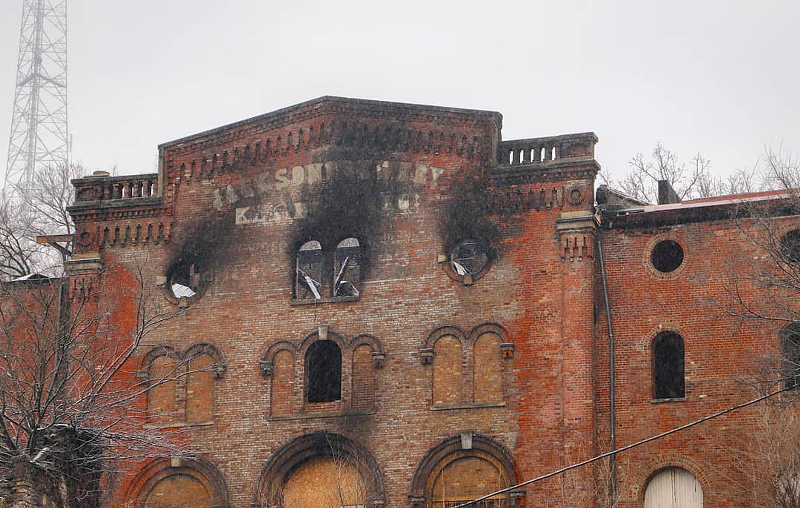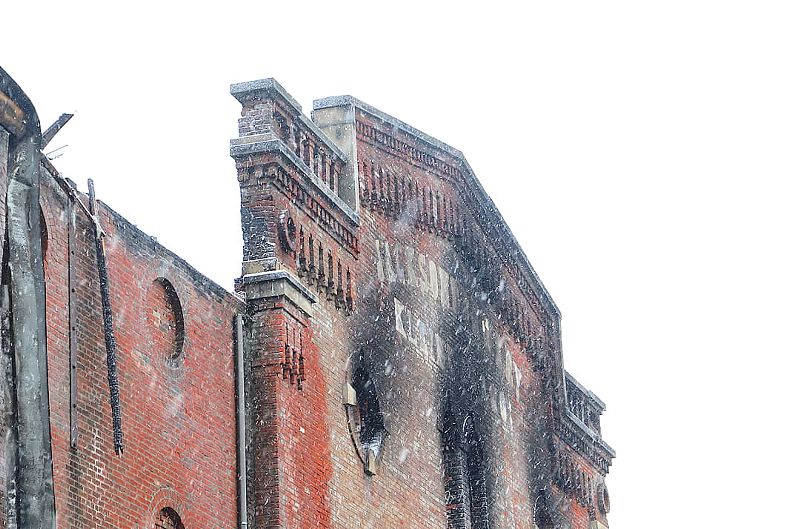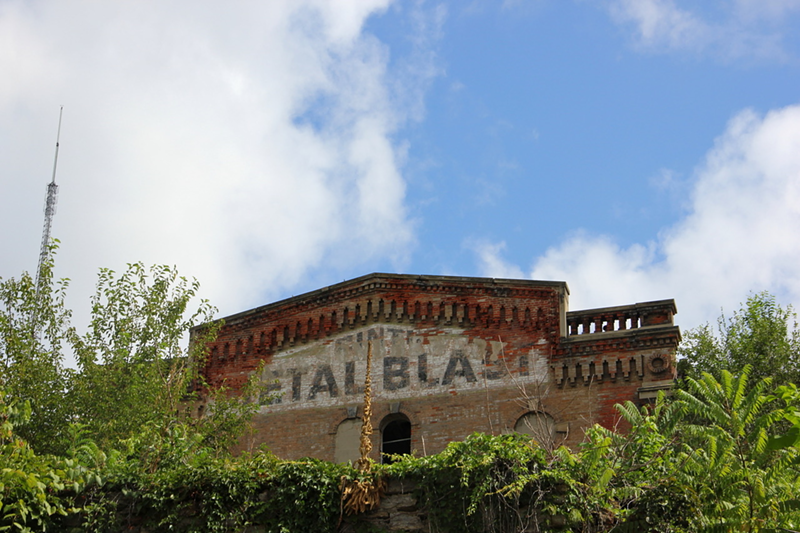If you listened closely early Sunday morning, you could hear the pained groans of Cincinnati's historic preservation community as northern Over-the-Rhine's Jackson Brewery warehouse building lay smoldering.
A large fire in the early hours of Dec.15 caused the roof to collapse at about 5:30 in the morning and led Cincinnati firefighters to declare the building that looms over Elm Street a "total loss," though at least two Cincinnati City Councilmembers say there are no immediate plans to demolish the cavernous structure. Damage to the building is estimated at $250,000. CFD has not announced the cause of the blaze and says it is investigating whether it could have been arson.
Whether the so-called Metal Blast building can survive the fire is still up in the air. At stake: a building with a significant — and sometimes dramatic — history in the Queen City.
The Jackson Brewing Company launched in 1829 in Cincinnati in honor of the election of President Andrew Jackson. The building that caught fire over the weekend was built by the company in 1850, according to records with the Hamilton County Auditor. The auditor's site lists the building at 35,000 square feet, though other reports say the whole facility is as big as 60,000 square feet.
The construction of the brewery nestled into the Cincinnati hillside was no accident — it allowed for the site's now-iconic lagering tunnels, which aided in the brewing of lager-style beer.
The site served as Jackson Brewery's home off and on for roughly 100 years afterward. It was a wild ride.
In the 1870s, ownership disputes sparked an armed standoff in the brewery, according to historic newspaper research conducted by Cincinnati historian Greg Hand. Hotelier George Weber bought the brewery in 1873 from the Kleiner brothers, who had run it for more than 40 years.
Unfortunately for Weber, the brewery soon went bankrupt, according to Hand's research. That led to legal proceedings in which Weber was stripped of control of the company so that court assignees Jacob Plau, Jr. and Alexander Starbuck could nurse the business back to health and pay off its debts.
Not happy to sit on the sidelines, Weber eventually convinced the court to install his friend, Leo Brigel, in place of Plau and Starbuck. But the crew at the brewery, led by foreman William Gerst, were loyal to the court's original representatives, and Brigel and other office staff ended up brandishing guns in a face-off with the plant's workers, who had also armed themselves with rifles, pistols and hot pokers. The police eventually arrived and helped Brigel take control of the brewery, newspaper accounts say. A reported 400 gallons of beer — but no blood — was spilled during the standoff.
Brigel and Weber had a falling out in 1882 when Weber sought to regain full control of the company. During an attempt by Brigel to force his way into the Jackson Brewery offices, a fight broke out between the two men in which Brigel bit Weber's fingers and Weber hit Brigel in the face, according to newspaper reports unearthed by Hand. Eventually, aided by the courts, Weber was again at the wheel of the company, which he renamed the George Weber Brewing Company. Though it expanded its distribution significantly under Weber's various degrees of ownership and produced 100,000 barrels of beer in 1885, it went bankrupt again in 1887.
New owners — including Brigel — swooped in after the bankruptcy and changed the name back to Jackson Brewing Company. Prohibition halted the production of beer there in 1919, but workers still made other, non-alcoholic beverages onsite. The building hummed back to life with a major expansion in 1933 and began producing "Old Jackson" beer, but the group of Detroit investors who purchased it called it quits in 1941, causing the building's final exit from brewing.
Afterward, the building served as a distribution hub for the Gibson Wine Company and later was the home of the Cincinnati Metal Blast Company, which did its own major overhaul of the property. Metal Blast also painted its name on the crown of the building where the Jackson Brewing Company logo had been, sparking the building's current nickname.
After Metal Blast's departure, the A-Z Restaurant Supply Company occupied the building for a time. When they left in the 1990s, the building fell vacant. An LLC owned by Fred Berger called Historic Limited Liability has held the property since 2012, according to the Hamilton County Auditor's site.
"Work continues on the historic Jackson Brewery," an undated post on the LLC's website reads. "Efforts to restore this building to its original glory include extensive roof and masonry work."
While the Metal Blast building isn't as iconic as say, Music Hall or Union Terminal, a lot of Cincinnati residents recognize it and appreciate its long presence in northern OTR. In 2014, voters named it one of Cincinnati's top 50 historic sites in a poll conducted by the Cincinnati Preservation Association.
There have been a number of plans to redevelop the property since A-Z left, usually focusing on repurposing the site for art, music, brewing or some combination thereof. But the property's large size and condition make those efforts challenging. They'll likely become even more so with the damage done by the fire.
But preservation advocates haven't given up hope yet. The building, one of the oldest remaining brewery facilities in Cincinnati, sits among a larger group of historic brewery sites and looms over a recently-christened local historic district.
"We're going to work very hard with the property owner and the other partners to make sure the building stands for another 100 years, but there's definitely a long road ahead of us," OTR Brewery District Executive Director Steve Hampton told WCPO yesterday.








